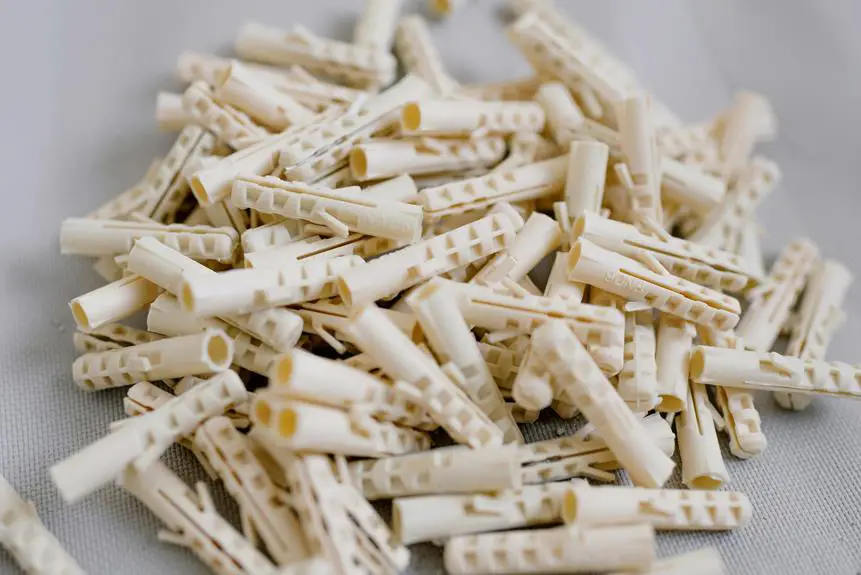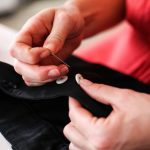When you've got a piece of batiste fabric in need of repair, it's crucial to start by assessing the damage. You'll want to look for tears, frays, or stains that could compromise its delicate nature. After that, gathering the right tools—like sharp fabric scissors and fine needles—will set you up for success. But knowing how to tackle those small tears or snags can be tricky. Let's explore some practical steps to ensure your repairs are both effective and discreet, so your fabric remains as beautiful as ever.
Table of Contents
Assessing the Damage
Before you start any repairs, take a close look at the batiste fabric to identify the extent of the damage. Check for tears, frays, or discoloration. Pinpointing the issues will help you determine the best course of action. If you notice small holes, assess whether they're near seams or isolated areas. For frays, examine the edges to see how much fabric is affected.
Next, evaluate the overall condition of the fabric. Is it thin or heavily worn? This'll influence how you approach the repairs. If the fabric feels fragile, you'll need to be extra gentle during the process. Look for any stains that might require special treatment. If they're present, consider whether cleaning the area first would improve the repair's appearance.
It's also essential to check the surrounding fabric for any signs of wear. Sometimes, damage can spread, and addressing it early can save you from bigger repairs later. Take notes on what you find; these can guide your repair strategy.
With a clear understanding of the damage, you can proceed confidently to the next steps in the repair process.
Gathering Repair Materials
Before you start repairing your batiste fabric, you need to gather the right materials.
Make sure you have essential repair tools like scissors and needles, as well as suitable fabric repair supplies.
With everything on hand, you'll be ready to tackle those repairs efficiently.
Essential Repair Tools
To tackle repairs on batiste fabric effectively, you'll need a few essential tools and materials at your disposal.
Start with a good pair of fabric scissors; sharp scissors will help you make clean cuts, ensuring your repairs look neat. A seam ripper is also crucial for removing any damaged stitches without harming the surrounding fabric.
Next, gather needles specifically designed for lightweight fabrics. A fine, sharp needle will glide through batiste without creating large holes. You'll also want to have a selection of thread in colors that match your fabric; this makes your repairs blend in seamlessly.
Don't forget a measuring tape to accurately size your patches or any alterations. A small iron can be extremely helpful for pressing seams flat, ensuring your work looks polished. Additionally, a pin cushion and straight pins are essential for holding pieces in place while you sew.
Lastly, consider having a fabric marking pen or chalk on hand for precise measurements and markings. With these tools ready, you'll find repairing batiste fabric becomes a manageable and rewarding task.
Fabric Repair Supplies
Gathering the right repair materials is crucial for ensuring your batiste fabric repairs are effective and lasting.
Start by selecting a matching thread, as this will help your stitches blend seamlessly with the fabric. Look for lightweight, cotton thread that won't add bulk.
Next, you'll need some fabric patches; lightweight batiste or a similar fabric works best. Make sure the color and texture align well with your original fabric to maintain consistency.
You'll also want to have a pair of sharp scissors on hand for clean cuts. A seam ripper can be useful if you need to remove old stitching or frayed edges.
Don't forget about a needle that's suitable for delicate fabrics—an embroidery needle or needle for fine fabrics will do the trick.
For additional support, consider fabric glue or fusible interfacing to help reinforce weak spots.
Cleaning the Fabric
Before you start cleaning your batiste fabric, you'll want to prepare properly to avoid damage.
Understanding the right washing techniques is crucial for maintaining its delicate texture, and drying methods can make a big difference too.
Let's explore these important steps to keep your fabric looking its best.
Pre-Cleaning Preparations
Start by inspecting the batiste fabric for any stains, tears, or discoloration that need attention. Take your time to examine the fabric closely, as even minor imperfections can affect the cleaning process. Make a note of any issues you find so you can address them later.
Next, gather your supplies to ensure you're prepared for the cleaning process. Use the following table as a guide to help you organize what you need:
| Item | Purpose | Notes |
|---|---|---|
| Mild detergent | To clean the fabric gently | Avoid harsh chemicals |
| Soft brush | For pre-treatment of stains | Use a gentle touch |
| Clean cloth | For blotting and drying | Keep it lint-free |
| Water | To dilute detergent | Use lukewarm water |
| Stain remover | For tough stains | Test on an inconspicuous area |
With your supplies in hand, you're ready to start pre-treating any stains and preparing the fabric for washing. Always remember to handle batiste gently, as it's delicate and can be easily damaged if not treated with care.
Washing Techniques
To effectively wash batiste fabric, choose a gentle cycle on your washing machine and use lukewarm water to prevent any damage.
Start by placing your batiste items in a mesh laundry bag. This extra layer of protection helps avoid snags and tangling with other garments.
If you're dealing with stains, pre-treat them gently by applying a mild detergent directly to the affected area and letting it sit for about 10 minutes before washing.
When you add detergent, opt for a mild, liquid type to ensure it dissolves well and doesn't leave residue. Avoid bleach or fabric softeners, as these can harm the delicate fibers of batiste.
Once your washing cycle is complete, it's important to handle the fabric carefully. Don't wring or twist the fabric to remove excess water; instead, press it gently between two clean towels to absorb moisture.
If you notice any discoloration or spots after washing, don't panic. Sometimes, a second gentle wash can help restore the fabric's original look.
Drying Methods
After washing your batiste fabric, it's crucial to dry it properly to maintain its delicate texture and appearance. Improper drying can lead to wrinkles, shrinkage, or even damage to the fibers.
Here are a few effective drying methods to consider:
- Air Drying: Lay your fabric flat on a clean, dry towel or hang it on a clothesline away from direct sunlight to prevent fading.
- Avoid Heat: If you use a dryer, select a low-heat setting and remove the fabric while it's still slightly damp to prevent over-drying.
- Use a Press Cloth: When ironing, place a thin cloth over the batiste to protect it from direct heat, ensuring you don't scorch the fabric.
- Gentle Handling: Don't wring out the fabric. Instead, gently press the water out using your hands or roll it in a towel.
Choosing the Right Stitch
Selecting the right stitch is crucial for ensuring that your repairs on batiste fabric are both secure and aesthetically pleasing. Since batiste is lightweight and delicate, using the wrong stitch can lead to further damage. You'll want to consider both the type of repair and the thread you're using.
Here's a quick guide to help you choose the best stitch for your batiste repairs:
| Stitch Type | Best Use |
|---|---|
| Straight Stitch | Basic seams or hems |
| Zigzag Stitch | Edges that need reinforcement |
| Slip Stitch | Invisible hems or repairs |
| Blind Hem Stitch | Hemming without visible stitches |
| Whip Stitch | Quick repairs on non-visible areas |
When you choose a stitch, think about the fabric's drape and how much tension the repair will face. A straight stitch works well for simple seams, while a zigzag stitch adds flexibility. Always test your stitch on a scrap piece of batiste to ensure it holds up without causing puckering or tearing. With the right stitch, your repairs will blend seamlessly into the fabric, keeping your items looking beautiful.
Repairing Small Tears
Occasionally, small tears in batiste fabric can be easily repaired with a few simple techniques to restore its beauty and functionality. Start by assessing the tear's size and location. If it's a minor tear, you can often fix it by using a needle and thread. Choose a thread color that closely matches the fabric to ensure a seamless repair.
Follow these steps for a successful repair:
- Gather materials: You'll need a needle, thread, scissors, and an iron.
- Prepare the area: Lay the fabric flat on a clean surface to work comfortably.
- Pin the edges: Align the torn edges and use pins to hold them together.
- Sew the tear: Use a straight stitch or a zigzag stitch, depending on the fabric's weight, ensuring you catch both sides of the tear.
Fixing Snags and Pulls
In addition to small tears, batiste fabric can also suffer from snags and pulls that need prompt attention to prevent further damage.
When you notice a snag, don't panic. Grab a pair of sharp scissors and gently trim the snagged thread to prevent it from pulling further. Be careful not to cut too close to the fabric, as this can create an unsightly gap.
Next, if the snag is significant, you can use a needle and thread to weave the loose thread back into place. Choose a thread color that matches your fabric closely for a seamless repair. Insert the needle into the fabric, catching the surrounding threads, and pull through gently. Repeat this process until the snag is secured.
For minor pulls, you can often coax the fabric back into shape by gently tugging the surrounding threads. Use your fingers to smooth the area and restore the fabric's original appearance.
If the pull is stubborn, consider using a fabric adhesive to hold the threads in place temporarily. Always test any adhesive on a hidden area first to ensure it won't harm your batiste.
Preventive Care Tips
Regularly inspecting your batiste fabric for signs of wear can help you catch potential issues before they become serious problems. By adopting some preventive care habits, you can extend the life of your delicate fabric and keep it looking fresh.
Here are some essential tips to maintain your batiste fabric:
- Store properly: Keep your batiste items in a cool, dry place away from direct sunlight to prevent fading and damage.
- Avoid harsh chemicals: Use mild detergents when washing to protect the fabric's fibers and color.
- Follow care labels: Always adhere to the washing and drying instructions specified on the care labels to avoid shrinking or distortion.
- Use a gentle cycle: When machine washing, opt for a gentle cycle and cold water to minimize friction and wear.
Frequently Asked Questions
Can I Use a Sewing Machine for Batiste Repairs?
Yes, you can use a sewing machine for repairs. Just ensure you use a fine needle and a lightweight thread to prevent damaging the delicate fabric. It'll help you achieve neat, secure stitches for your project.
What Is the Best Thread Type for Batiste Fabric?
For batiste fabric, you'll want to use a fine, lightweight thread like polyester or cotton. These threads provide strength without adding bulk, ensuring your seams remain delicate and blend seamlessly with the fabric's texture.
Is Batiste Fabric Washable After Repairs?
Yes, batiste fabric is washable after repairs. Just ensure you use a gentle cycle and mild detergent. It's best to air dry to maintain the fabric's integrity and prevent any potential damage from high heat.
How Do I Store Batiste Fabric to Prevent Damage?
To store batiste fabric and prevent damage, you'll want to keep it in a cool, dry place. Use acid-free tissue paper to wrap it, and avoid direct sunlight to maintain its quality.
Can I Dye Batiste Fabric After Repairing It?
Yes, you can dye batiste fabric after repairing it. Just make sure the repairs are secure and the fabric is clean. Choose a dye suitable for the fabric, and follow the dyeing instructions carefully.
- Tetron Fabric for Marine Applications: Durability and Use Cases - June 18, 2025
- Tetron Fabric for Outdoor Furniture: Weather Resistance and Care - June 18, 2025
- Tetron Fabric for Wall Coverings: Style and Application Tips - June 18, 2025







